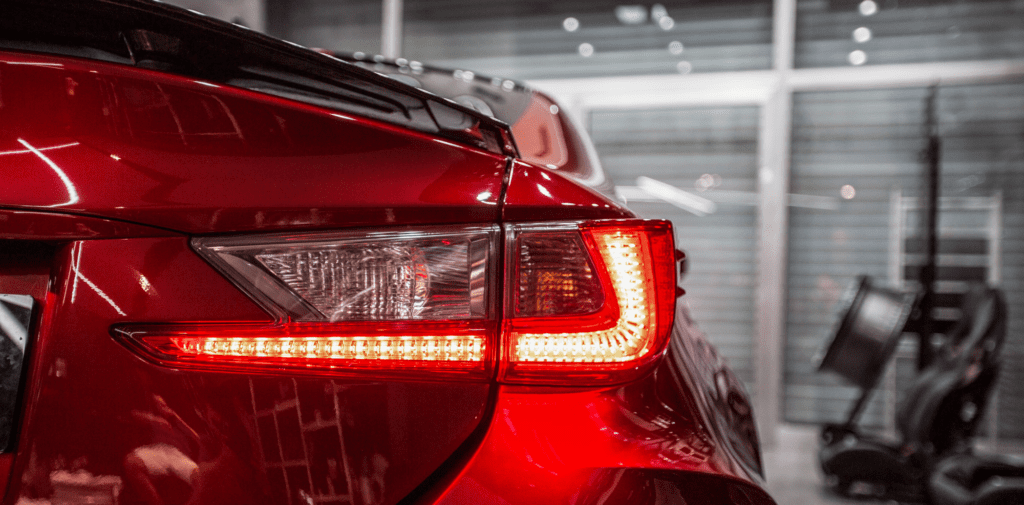
Introduction
Importance of Understanding Car Lights
Driving safely is an essential part of everyday life, and understanding the various car lights is a crucial component of this.
Proper usage of car lights not only ensures the safety of the driver and passengers but also enhances the overall driving experience and helps prevent accidents.
Car lights serve multiple functions, from improving visibility during adverse weather conditions to signalling intentions to other road users.
Therefore, having a comprehensive knowledge of car lights and when to use them is vital for every driver.
Overview of Different Types of Car Lights
Car lighting systems have evolved significantly over the years, incorporating various technologies to improve safety and efficiency.
The modern car is equipped with multiple types of lights, each designed for specific purposes.
These include:
- Headlights
- Tail lights
- Fog lights
- Indicators
- Brake lights
- Reverse lights, and more.
Each light serves a distinct function, whether it’s illuminating the road ahead, indicating a turn, or enhancing the car’s visibility to others.
Understanding the specific purposes and appropriate usage of each type of light is essential for responsible driving.
What Are the Different Types of Lights?
Overview of Car Lighting Systems
The car lighting system is an integral part of vehicle design, ensuring that the driver can see and be seen under various conditions.
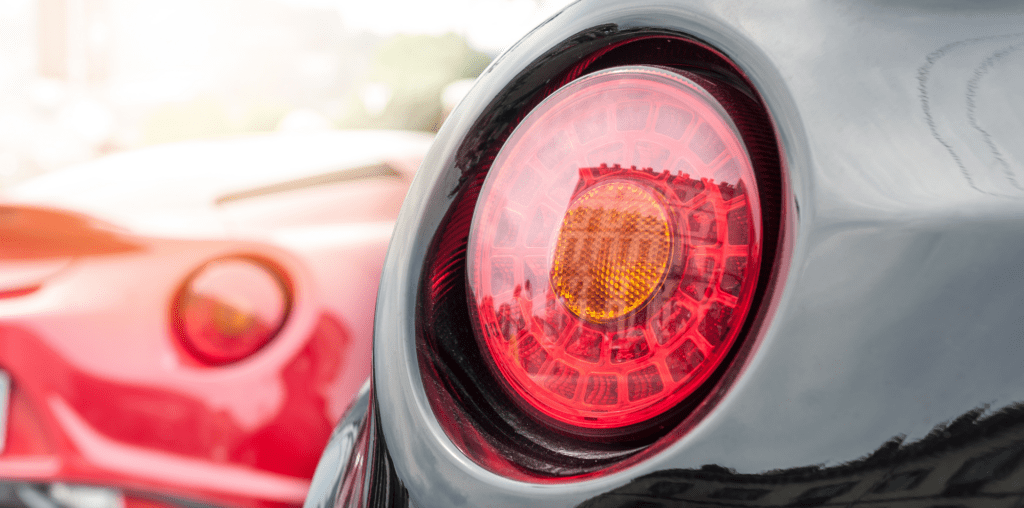
The system comprises several lights, each contributing to the overall safety and functionality of the vehicle.
- Headlights are arguably the most important lights on a vehicle. They illuminate the road ahead and make the car visible to oncoming traffic. Modern headlights often feature different settings, such as low beam and high beam, to cater to different driving conditions.
- Tail lights are located at the rear of the vehicle and light up when the headlights are on. They signal the car’s presence to vehicles behind it, especially in low visibility conditions.
- Fog lights are designed to cut through fog, rain, and dust. They are usually positioned lower on the vehicle and emit a wide, bar-shaped beam to enhance visibility close to the ground.
- Indicators or turn signals inform other road users of your intention to turn or change lanes. They flash intermittently to catch the attention of other drivers and pedestrians.
- Brake lights illuminate when the driver presses the brake pedal, signalling to other drivers that the vehicle is slowing down or stopping.
- Reverse lights are activated when the car is put into reverse gear. They illuminate the area behind the car and alert others that the vehicle is about to move backwards.
- Daytime running lights (DRLs) are a relatively new addition to the car lighting system. They are designed to make the car more visible during the day.
Importance of Using the Correct Lights
Using the correct car lights at the right time is crucial for road safety. Each type of light serves a specific purpose and ensures that the vehicle can be seen under different conditions. Misusing car lights can lead to confusion, accidents, and even legal issues.
For instance, using high beam headlights in urban areas or when there is oncoming traffic can blind other drivers, increasing the risk of accidents.
Similarly, failing to use indicators when changing lanes or turning can result in collisions.
Fog lights should only be used in foggy or low visibility conditions. Using them in clear weather can dazzle other drivers and is illegal in many regions.
Proper use of brake lights and reverse lights is also essential. These lights communicate critical information to other road users, such as when the vehicle is stopping or reversing.
In summary, understanding and correctly using the various car lights not only ensures compliance with traffic laws but also significantly enhances road safety for all.
Headlights
Dipped Headlights
Dipped headlights, also known as low beam headlights, are a crucial component of a vehicle’s lighting system.
They provide sufficient illumination for night-time driving and poor weather conditions without causing excessive glare to other road users.
Unlike full beam headlights, dipped headlights are angled downwards to illuminate the road directly in front of the vehicle.
When to Use Dipped Headlights
Dipped headlights should be used in a variety of situations to ensure safety and compliance with traffic regulations. Here are some scenarios when dipped headlights are necessary:
- Night-time driving: Whenever driving after dusk and before dawn, dipped headlights are essential to illuminate the road while minimising glare for other drivers.
- Poor weather conditions: In rain, fog, snow, or mist, dipped headlights improve visibility. They help the driver see the road and make the vehicle more visible to others.
- Twilight hours: During dawn and dusk, when natural light is insufficient, dipped headlights should be used to enhance visibility.
- In tunnels and shaded areas: When driving through tunnels or heavily shaded areas, dipped headlights help maintain consistent visibility.
- When following another vehicle: To avoid dazzling the driver ahead, dipped headlights should be used when driving behind another vehicle.
What Does the Highway Code Say?
The Highway Code provides specific guidelines regarding the use of dipped headlights to ensure safety on the roads. According to the Highway Code:
- Rule 113: Headlights must be used at night and when visibility is seriously reduced. Night-time is defined as the period between half an hour after sunset and half an hour before sunrise.
- Rule 114: Use dipped headlights at night in built-up areas and in dull daytime weather to ensure that you can be seen.
- Rule 115: When driving in poor visibility conditions, such as fog, heavy rain, or snow, dipped headlights should be used. This helps other road users see you more easily.
Full Beam Headlights
Full beam headlights, also known as high beam headlights, provide a powerful, long-range beam of light that illuminates the road far ahead.
They are designed for use in situations where maximum visibility is required, such as on rural roads without street lighting.

When to Use Full Beam Headlights
Full beam headlights are suitable for specific driving conditions. Here are the recommended scenarios for their use:
- Rural and unlit roads: When driving on dark, rural roads without street lighting, full beam headlights provide the necessary illumination to see further ahead.
- Open motorways: On motorways with no oncoming traffic, full beam headlights can enhance visibility.
- Night-time with no nearby traffic: Use full beams in areas where there are no other vehicles around to maximise visibility.
Avoiding Dazzling Other Drivers
One of the primary concerns with using full beam headlights is the potential to dazzle other drivers, which can lead to dangerous situations. Here are some tips to avoid causing glare:
- Dip your headlights: When you see oncoming traffic, switch from full beam to dipped headlights to avoid blinding the other driver.
- Check for reflections: Look for reflections of your headlights on road signs or the rear of other vehicles, which can indicate your full beams are causing glare.
- Follow the Highway Code: Rule 114 of the Highway Code specifies that you must not use full beam headlights when meeting or following another vehicle. Always switch to dipped headlights in these situations.
- Be mindful of other road users: Remember that cyclists and pedestrians can also be dazzled by full beam headlights. Use dipped headlights when passing them.
Automatic Headlights
Automatic headlights are a modern convenience found in many new vehicles. These headlights use sensors to detect ambient light levels and automatically switch the headlights on or off as needed.
How Automatic Headlights Work
Automatic headlights function through a system of sensors, usually mounted on the dashboard or rear-view mirror, that measure the intensity of ambient light.
When the sensors detect a decrease in light levels, such as during dusk or when entering a tunnel, they signal the car’s lighting system to activate the headlights.
Conversely, when the sensors detect sufficient light, the headlights are automatically turned off.
The system can also include additional features, such as automatic high beam control, which switches between dipped and full beams based on the presence of oncoming traffic or vehicles ahead.
Benefits of Automatic Headlights
Automatic headlights offer several advantages, enhancing both convenience and safety:
- Improved safety: By ensuring that headlights are always used appropriately, automatic headlights reduce the risk of driving without proper illumination, which can lead to accidents.
- Convenience: Drivers no longer need to manually switch headlights on and off, reducing the likelihood of forgetting to turn them on in low light conditions.
- Extended headlight life: Automatic systems can help prolong the lifespan of headlights by optimising their usage, preventing them from being left on unnecessarily.
- Enhanced driving experience: Automatic headlights can make driving more comfortable, especially in changing light conditions, as the system seamlessly adjusts the lighting without driver intervention.
Understanding the various types of car lights and their appropriate usage is fundamental for safe driving.
Dipped headlights, full beam headlights, and automatic headlights each serve specific purposes and enhance visibility under different conditions.
By adhering to the guidelines set forth by the Highway Code and utilising these lights correctly, drivers can significantly improve safety for themselves and others on the road.
Daytime Running Lights (DRLs)
Purpose of Daytime Running Lights
Daytime Running Lights (DRLs) are designed to enhance the visibility of a vehicle during daylight hours.
Unlike headlights, DRLs are not intended to illuminate the road ahead but rather to make the vehicle more noticeable to other road users, thereby reducing the risk of daytime accidents.
DRLs are typically positioned at the front of the vehicle and are activated automatically when the engine is started.
When to Use DRLs
DRLs are designed to be used during daylight hours to increase the vehicle’s visibility. In many modern cars, DRLs turn on automatically when the engine is started, so drivers do not need to manually activate them.
However, it is important to ensure that the DRLs are functioning correctly, especially if they are not automatic.
Legal Requirements for DRLs
In the UK, the use of DRLs is mandated for all new cars sold since February 2011. According to the European Union regulations, which the UK follows, DRLs must be fitted to improve road safety.

These regulations require that DRLs be bright enough to be visible in daylight but not so bright as to cause glare to other road users.
Fog Lights
Front Fog Lights
Front fog lights are designed to provide better visibility in foggy, misty, or hazy conditions. They are positioned lower on the vehicle to illuminate the road surface more effectively and reduce the amount of light reflected back by fog, rain, or snow.
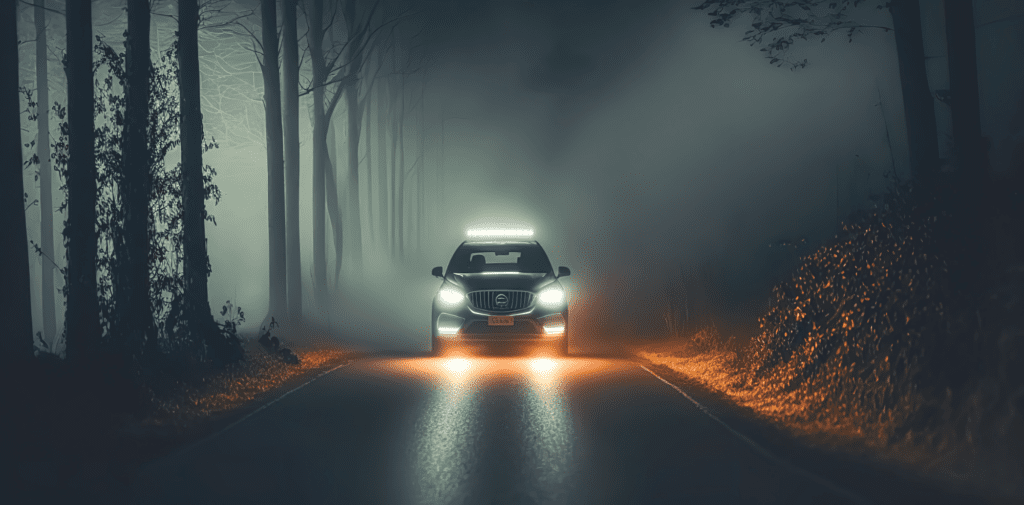
When to Use Front Fog Lights
Front fog lights should be used in conditions where visibility is severely reduced, typically when you cannot see more than 100 metres ahead.
These lights are designed to cut through the fog and provide a clearer view of the road and surrounding area.
Highway Code Guidelines
The Highway Code provides specific rules regarding the use of front fog lights to ensure that they are used appropriately:
- Rule 114: Only use front fog lights when visibility is seriously reduced, i.e., when you cannot see more than 100 metres. They should not be used at other times as they can dazzle other road users and cause glare.
- Rule 226: When driving in fog, use your front fog lights in addition to your dipped headlights. However, switch them off when visibility improves to avoid dazzling other road users.
Rear Fog Lights
Rear fog lights are an important safety feature designed to make your vehicle more visible to others from behind in severely reduced visibility conditions.
They emit a strong, bright red light that can penetrate fog, heavy rain, or snow, alerting other drivers to your presence.
When to Use Rear Fog Lights
Rear fog lights should be used in similar conditions to front fog lights, typically when visibility is less than 100 metres.
Their purpose is to ensure that your vehicle can be seen by drivers approaching from behind, thereby reducing the risk of rear-end collisions.
Avoiding Misuse of Rear Fog Lights
Misusing rear fog lights can cause significant problems for other road users. Here are some guidelines to avoid misuse:
- Turn off in clear conditions: Once visibility improves beyond 100 metres, rear fog lights should be turned off. Using them in clear conditions can dazzle drivers behind you, causing discomfort and potentially leading to accidents.
- Avoid using in light mist or rain: Rear fog lights are not necessary in light mist or rain where visibility is not severely reduced. Use your regular tail lights in these conditions.
- Follow the Highway Code: According to Rule 236 of the Highway Code, you must not use rear fog lights unless visibility is seriously reduced. This helps prevent dazzling other drivers and ensures that rear fog lights are only used when truly necessary.
Understanding the correct usage of Daytime Running Lights (DRLs), front fog lights, and rear fog lights is essential for safe driving.
By adhering to the legal requirements and guidelines set out in the Highway Code, drivers can ensure they are using their vehicle’s lighting systems effectively, enhancing visibility and safety for all road users.
Indicator Lights
Purpose of Indicator Lights
Indicator lights, also known as turn signals, are a critical part of a vehicle’s signalling system. Their primary purpose is to communicate the driver’s intention to turn or change lanes to other road users.

This advance warning helps to prevent collisions by allowing other drivers and pedestrians to anticipate the vehicle’s movements and respond accordingly.
Proper Use of Indicators
Using indicator lights correctly is essential for safe driving. Here are some guidelines on the proper use of indicators:
- Turning: Always use your indicators to signal your intention to turn, whether turning left or right at an intersection. Activate the indicator well before the turn to give other road users ample warning.
- Changing lanes: Use indicators to signal lane changes on motorways and other multi-lane roads. This alerts drivers in adjacent lanes to your intentions, reducing the risk of accidents.
- Exiting roundabouts: Signal your intention to exit a roundabout to inform other road users and help maintain a smooth flow of traffic.
- Merging: When merging into traffic, use your indicators to show your intention to join the flow of vehicles.
Common Mistakes with Indicators
Misuse or failure to use indicator lights can lead to dangerous situations. Here are some common mistakes and how to avoid them:
- Not using indicators: Failing to use indicators is a common and dangerous mistake. Always signal your intentions to ensure that other road users are aware of your actions.
- Late signalling: Indicating too late gives other drivers insufficient time to react. Always activate your indicators well in advance of turning or changing lanes.
- Leaving indicators on: Forgetting to turn off indicators after completing a manoeuvre can confuse other drivers. Always ensure your indicators are cancelled after a turn or lane change.
- Inconsistent use: Inconsistently using indicators can lead to unpredictable driving behaviour, increasing the risk of accidents. Make it a habit to use indicators consistently in all relevant situations.
Brake Lights
Function of Brake Lights
Brake lights are crucial for road safety. They illuminate when the brake pedal is pressed, signalling to other road users that the vehicle is slowing down or stopping.
This advance warning allows following drivers to adjust their speed accordingly, preventing rear-end collisions.
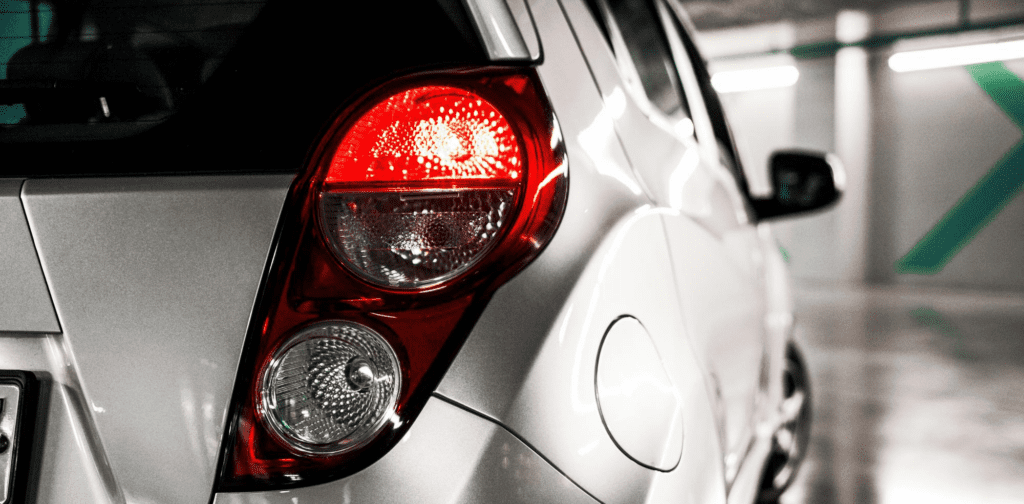
Checking Brake Light Functionality
Regularly checking the functionality of your brake lights is essential to ensure they are working correctly. Here’s how to check your brake lights:
- Visual inspection: Park your car in a safe location and have someone stand behind the vehicle. Press the brake pedal and ask the person to confirm that all brake lights, including the centre high-mounted stop light (CHMSL), are illuminating.
- Reflections: If you are alone, you can use reflective surfaces such as windows or mirrors to check if the brake lights illuminate when you press the brake pedal.
- Warning lights: Modern vehicles may have dashboard indicators that alert you when a brake light is not functioning. Pay attention to these alerts and address any issues promptly.
Importance of Responsive Brake Lights
Having responsive brake lights is crucial for road safety. Here’s why they are important:
- Prevents accidents: Responsive brake lights give other drivers immediate warning that your vehicle is slowing down or stopping, allowing them to react in time to avoid a collision.
- Compliance with the law: Properly functioning brake lights are a legal requirement. Driving with faulty brake lights can result in fines and penalties.
- Improved communication: Brake lights are a form of non-verbal communication with other road users. Clear and immediate signalling of your braking intentions helps maintain smooth and predictable traffic flow.
- Increased visibility: Bright and responsive brake lights ensure that your vehicle is visible to others, especially in adverse weather conditions or low-light situations.
Understanding the correct use and maintenance of indicator lights and brake lights is essential for safe and responsible driving.
By following proper usage guidelines and regularly checking the functionality of these lights, drivers can significantly enhance road safety for themselves and others.
Hazard Lights
When to Use Hazard Lights
Hazard lights, also known as warning lights or emergency flashers, are designed to alert other road users to a potential hazard or unusual situation involving your vehicle.
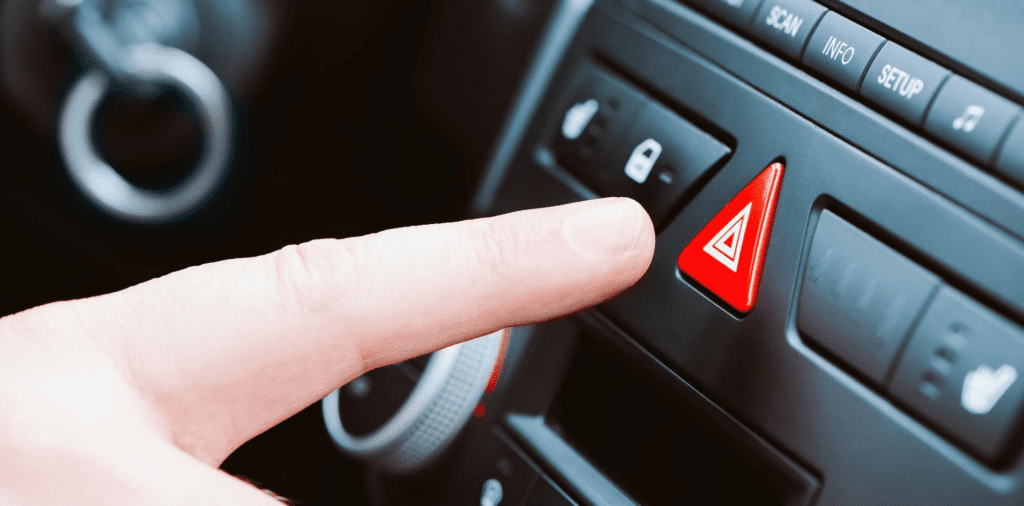
They are used to indicate that your vehicle is stationary and poses a risk to other traffic. Here are the appropriate scenarios for using hazard lights:
- Breakdowns: If your vehicle breaks down and you are forced to stop in a potentially dangerous location, such as on the side of a busy road or motorway, activate your hazard lights to alert other drivers.
- Accidents: If you are involved in an accident and your vehicle is obstructing the road, use hazard lights to warn other road users of the obstruction.
- Obstructions: When you need to stop suddenly due to an obstruction on the road, such as fallen debris or an unexpected hazard, use your hazard lights to warn vehicles behind you.
Legal Restrictions on Hazard Light Use
While hazard lights are essential for safety, their use is subject to legal restrictions to prevent misuse and confusion.
The Highway Code and UK law outline specific circumstances under which hazard lights should be used:
- Rule 116: You must only use hazard warning lights when your vehicle is stationary, to warn that it is temporarily obstructing traffic. For example, when you have broken down or stopped to help others.
- Not for regular stops: Do not use hazard lights when parking illegally or making regular stops, such as waiting in traffic. Misuse can confuse other drivers and diminish the effectiveness of hazard lights in genuine emergencies.
- Moving vehicles: Hazard lights should not be used while driving, except when warning drivers behind you of a hazard or obstruction ahead. This use is generally limited to specific situations, such as if you need to slow down quickly due to a sudden incident.
Using Hazard Lights in Emergencies
Hazard lights are a crucial tool in emergency situations. Here’s how to use them effectively:
- Immediate activation: As soon as you encounter an emergency, such as a breakdown or accident, activate your hazard lights to alert other road users.
- Stay visible: In addition to using hazard lights, ensure that your vehicle is as visible as possible. Use reflective triangles if you have them and wear a high-visibility jacket if you need to exit the vehicle.
- Seek help: Once your hazard lights are on, contact emergency services or roadside assistance for help. Hazard lights signal to responders that you are in distress and need assistance.
Side Lights (Parking Lights)
Purpose of Side Lights
Side lights, also known as parking lights, are small, low-intensity lights located at the front and rear of a vehicle.
Their primary purpose is to make the vehicle visible when parked on the roadside, particularly in low light conditions or at night.
They are not designed to illuminate the road ahead but rather to signal the presence of a stationary vehicle to other road users.
When to Use Side Lights
Side lights should be used in specific situations to ensure safety and compliance with regulations:
- Parking at night: When parking on the roadside at night or in poor visibility conditions, use your side lights to make your vehicle visible to other drivers. This helps prevent accidents by ensuring that your parked car is noticed.
- Twilight hours: During dawn and dusk, when natural light is fading but it is not yet dark enough for full headlights, side lights can improve your vehicle’s visibility.
- Built-up areas: In some built-up areas, local regulations may require the use of side lights when parking at night, even if street lighting is present.
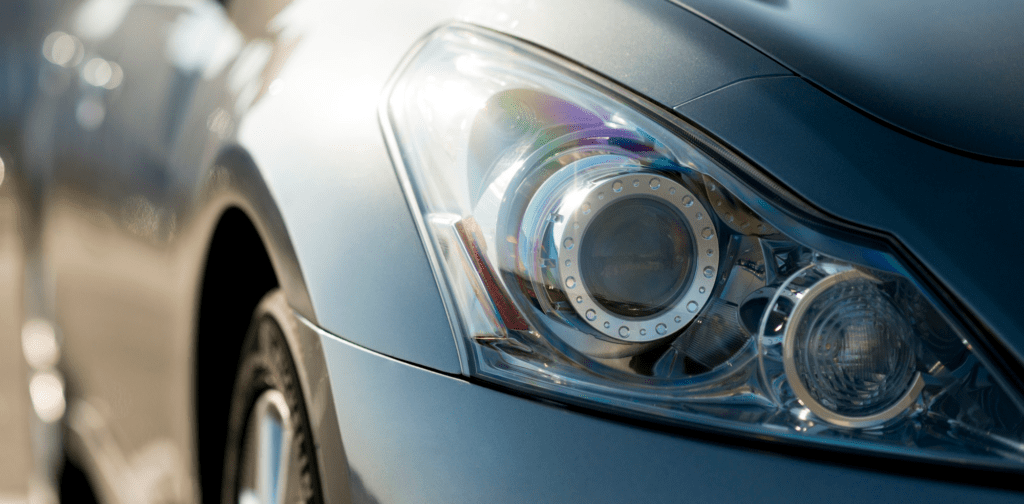
Legal Requirements for Side Lights
The use of side lights is regulated to ensure that vehicles are visible and do not pose a hazard when parked. The Highway Code and UK law provide guidelines on the use of side lights:
- Rule 113: Side lights must be used between sunset and sunrise when parked on a road with a speed limit greater than 30 mph. This rule ensures that vehicles parked on faster roads are visible to other traffic.
- Urban areas: In some urban areas, you may be required to use side lights when parking, depending on local regulations. Always check local signage and rules to ensure compliance.
- Parking regulations: Even if side lights are not legally required, it is good practice to use them when parking in poorly lit areas or where visibility is low to enhance safety for all road users.
Understanding the appropriate use of hazard lights and side lights (parking lights) is essential for safe and responsible driving.
By following legal requirements and guidelines, drivers can ensure their vehicle is visible and does not pose a hazard, whether moving or stationary.
Understanding Light Symbols on Your Dashboard
Common Light Symbols Explained
The dashboard of a modern vehicle is equipped with a variety of light symbols designed to inform the driver about the status and condition of the vehicle.
Understanding these symbols is crucial for maintaining your car and ensuring safety. Here are some common light symbols you might encounter:
- Check Engine Light: This symbol indicates an issue with the engine or emissions system. It can range from a minor problem, such as a loose fuel cap, to a more serious issue requiring immediate attention.
- Battery Warning Light: When this light illuminates, it suggests there is a problem with the vehicle’s charging system. This could be due to a faulty alternator, battery, or wiring.
- Oil Pressure Light: This light signals low oil pressure, which could lead to severe engine damage if not addressed promptly. It is crucial to check the oil level and pressure immediately.
- Brake System Light: If this light comes on, it could indicate a problem with the braking system, such as low brake fluid or an issue with the ABS (Anti-lock Braking System).
- Temperature Warning Light: This indicates that the engine is overheating. Stop the vehicle as soon as it is safe to do so and check the coolant level and cooling system.
- Tyre Pressure Monitoring System (TPMS) Light: This light alerts you when one or more tyres are significantly under-inflated, which can affect vehicle handling and safety.
- Airbag Warning Light: If this light is on, there may be an issue with the airbag system, which could prevent the airbags from deploying in the event of a collision.
- Service Required Light: This light reminds you that the vehicle is due for routine maintenance, such as an oil change or tyre rotation.
What to Do When a Light Symbol Appears
When a dashboard light symbol illuminates, it is essential to take appropriate action to address the issue. Here are some steps to follow:
- Understand the symbol: Refer to your vehicle’s owner manual to accurately identify the meaning of the light symbol.
- Assess the severity: Determine if the issue is urgent (such as the oil pressure light) or if it can wait (such as the service required light).
- Take immediate action if needed: For serious warnings, such as engine overheating or brake system issues, stop the vehicle as soon as it is safe and seek professional assistance.
- Schedule maintenance: For less urgent warnings, schedule a service appointment to have the issue addressed by a qualified mechanic.
- Reset the light: After resolving the issue, ensure that the warning light is reset. This may require a diagnostic tool or visiting a mechanic.
Regular Dashboard Light Checks
Regularly checking your dashboard lights ensures that you are aware of your vehicle’s condition and can address any issues promptly. Here are some tips for maintaining your dashboard lights:
- Pre-drive check: Before starting your journey, glance at the dashboard to ensure no warning lights are illuminated.
- Routine maintenance: During regular vehicle maintenance, ask your mechanic to check the functionality of the dashboard lights and address any underlying issues.
- Stay informed: Familiarise yourself with all the dashboard symbols and their meanings. This knowledge can help you respond appropriately when a warning light appears.
Legal Requirements and the Highway Code
Overview of Relevant Highway Code Sections
The Highway Code provides comprehensive guidelines on the use and maintenance of vehicle lights to ensure road safety. Some relevant sections include:
- Rule 113: This rule mandates the use of headlights and side lights when visibility is seriously reduced, ensuring that your vehicle is visible to other road users.
- Rule 114: This rule outlines the appropriate use of headlights at night and during poor visibility conditions, including when to use dipped and full beam headlights.
- Rule 115: This rule covers the use of fog lights and emphasizes that they should only be used in foggy conditions where visibility is seriously reduced.
- Rule 116: This rule specifies the correct use of hazard lights, highlighting that they should only be used when your vehicle is stationary and causing an obstruction.
Penalties for Incorrect Light Usage
Failure to comply with the Highway Code regarding vehicle lights can result in penalties. Some common infractions and their consequences include:
- Driving without lights in poor visibility: This can lead to fines and penalty points on your driving licence. It poses a significant safety risk as it reduces your visibility to other road users.
- Improper use of fog lights: Using fog lights when visibility is not seriously reduced can result in a fine. It can also cause glare and discomfort to other drivers.
- Faulty brake lights: Driving with faulty brake lights can attract fines and make your vehicle unsafe, increasing the risk of rear-end collisions.
- Incorrect use of hazard lights: Misusing hazard lights, such as using them while driving, can lead to penalties and cause confusion for other drivers.
Staying Updated with Legal Changes
Traffic laws and regulations, including those related to vehicle lights, can change over time. It is essential for drivers to stay informed about any updates to ensure compliance and maintain safety. Here are some ways to stay updated:
- Regularly review the Highway Code: The Highway Code is periodically updated to reflect new laws and best practices. Regularly reviewing it can help you stay informed about any changes.
- Driver education courses: Consider enrolling in driver education or refresher courses that cover the latest traffic laws and regulations.
- Official announcements: Follow official channels, such as government websites and announcements, for updates on traffic laws and vehicle requirements.
- Professional advice: Consult with your mechanic or vehicle service provider for advice on maintaining compliance with current regulations, particularly during regular vehicle maintenance and inspections.
Understanding and adhering to the guidelines and legal requirements for vehicle lights, as outlined in the Highway Code, is essential for safe and lawful driving.
By staying informed and taking proactive measures, drivers can ensure they are using their vehicle’s lighting systems correctly, enhancing safety for themselves and others on the road.
Frequently asked questions
Car lights include headlights (low beam and high beam), tail lights, fog lights (front and rear), indicator lights, brake lights, reverse lights, and daytime running lights (DRLs). Each type serves a specific purpose to enhance visibility and safety.
Dipped headlights should be used at night, during poor weather conditions (such as rain, fog, or snow), in tunnels, and during twilight hours. They provide sufficient illumination without blinding other road users.
DRLs are designed to make your vehicle more visible during the day, reducing the risk of daytime accidents. They automatically turn on when the engine is started.
Full beam headlights should be used on rural or unlit roads at night, where there is no oncoming traffic or vehicles ahead. They provide a bright, focused light to illuminate the road further ahead.
Fog lights are used in conditions where visibility is severely reduced, such as in fog, heavy rain, or snow.
Front fog lights help to illuminate the road directly in front of the vehicle, while rear fog lights make your vehicle more visible from behind.
The Highway Code mandates the use of headlights between sunset and sunrise, and in conditions of poor visibility.
Fog lights should only be used when visibility is less than 100 metres. Daytime running lights (DRLs) are required for all new cars sold since February 2011.
Automatic headlights use sensors to detect ambient light levels and automatically turn the headlights on or off as needed. This feature ensures that your headlights are used appropriately without manual intervention.
When a dashboard light symbol illuminates, refer to your vehicle’s owner manual to understand its meaning.
Assess the severity and take appropriate action, such as stopping the vehicle if it indicates a serious issue or scheduling maintenance for less urgent warnings.
Indicator lights communicate your intention to turn or change lanes to other road users. Proper use of indicators helps prevent accidents by allowing others to anticipate your vehicle’s movements.
You should check your brake lights regularly, ideally once a month, to ensure they are functioning correctly.
This can be done visually with the help of a reflective surface or by having someone check them while you press the brake pedal.
Penalties for incorrect use of car lights can include fines and penalty points on your driving licence. Misuse of fog lights, driving without lights in poor visibility, and driving with faulty brake lights can all result in penalties.
Hazard lights are used to alert other road users to a potential hazard or unusual situation, such as a breakdown or accident. They should only be used when your vehicle is stationary and causing an obstruction.
Side lights or parking lights are used to make your parked vehicle visible to other road users, especially at night or in low visibility conditions.
They are required when parking on roads with a speed limit greater than 30 mph between sunset and sunrise.
Stay updated with changes in traffic laws by regularly reviewing the Highway Code, enrolling in driver education courses, following official government announcements, and consulting with your mechanic during regular vehicle maintenance.
If your car lights are not working properly, check the bulbs and fuses first. If the issue persists, consult a qualified mechanic to diagnose and repair any electrical faults. Regular maintenance can help prevent such issues.



